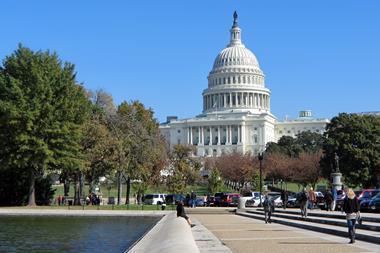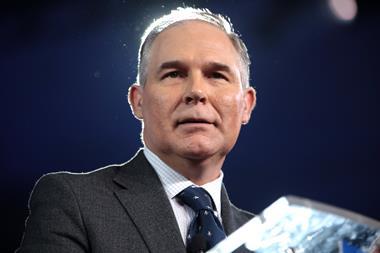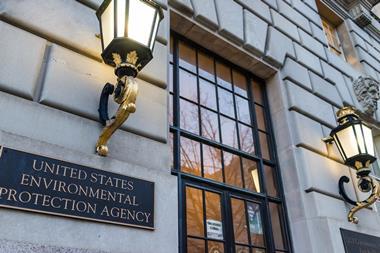US environment agency to end dalliance with country’s first limits on carbon emissions from coal-fired power plants
The Trump administration has taken action to repeal President Obama’s regulation that set the first-ever limits on carbon emissions from coal-fired power plants, much to the chagrin of previous Environmental Protection Agency (EPA) administrators and environmental groups, but to the apparent satisfaction of the chemical industry.
In its proposal to withdraw the Obama-era Clean Power Plan (CPP), the EPA argued that the regulation exceeds the agency’s statutory authority. Nixing the rule will help the development of US energy resources and reduce unnecessary regulatory burdens, the Trump administration claimed.
The war on coal is over
Scott Pruitt, EPA head
EPA administrator Scott Pruitt previewed the announcement when he addressed coal miners in Kentucky two days ago. ‘The war on coal is over,’ he told the audience, vowing to sign a proposed rule to revoke the CPP the next day. ‘The past administration was unapologetic – they were using every bit of power, every bit of authority, to use the EPA to pick winners and losers in how we generate electricity in this country.’
Finalised in August 2015, the CPP set national standards to reduce carbon dioxide emissions from the power sector by 32% from 2005 levels by 2030. The emission reductions were to be phased in gradually by 2030.
However, the regulation never actually took effect because the US supreme court granted a temporary stay last year while legal challenges were heard. More than two dozen states sued the EPA over the plan, and Pruitt himself participated in legal action as the then-attorney general of Oklahoma. At the time, he and the other plaintiffs described the CPP as a power grab.
Growth warning
The chemical industry appears supportive of the EPA’s decision. The American Chemistry Council (ACC) had expressed concern that the rule could undermine growth in the chemical sector by raising costs for businesses and consumers. The trade group argued that greenhouse gas emissions have and will continue to fall thanks to market forces, as well as existing state and regional policies.
Coal is dying because of the low cost of natural gas
Christine Todd Whitman, EPA head under President George W Bush
Opponents of the EPA’s action include two prominent former administrators of the agency, who argue that the biggest threat to coal plants is the rise of cheap and plentiful natural gas, not government regulation. ‘It is a bait and switch because is not going to bring coal back – coal is dying because of the low cost of natural gas,’ says Christine Todd Whitman, who ran the EPA under former Republican President George W Bush. She calls the proposal to withdraw the CPP ‘unconscionable’.
Whitman accuses the EPA of overlooking its responsibility to protect human health, noting that the agency itself found that the CPP would save lives. The EPA calculated that the rule would avoid 2700 to 6600 premature deaths and 140,000 to 150,000 asthma attacks in children.
Gina McCarthy, who led the EPA under Obama, echoes Whitman. ‘Instead of fulfilling their mission to keep our air and water clean, this administration is using stall tactics to defer their legal and moral obligation to reduce pollutants that threaten American families and fuel climate change,’ McCarthy said. ‘They want to replace our plan with a weaker standard sometime in the future, if they replace it at all. Shame on them – speak out.’
Regulatory uncertainty
Karen Palmer, an economist with Resources for the Future in Washington, DC, warns that these steps to repeal the CPP create ‘a lot of regulatory uncertainty’ in the industry. ‘The expectation is that there are ultimately going to need to be regulations of these emissions, since the EPA is required to do so by law, and so this introduces uncertainty about what that is going to look like,’ she says, noting that the supreme court has ruled that the EPA is obliged to regulate carbon emissions. ‘Power plants are long-lived assets, so this sector would like to have some sense of future regulatory requirements,’ Palmer asserts.
Further, she suggests that the White House used fuzzy math to arrive at a positive net benefit from repealing the existing CPP. Specifically, the Trump administration estimates that the rule’s reversal could help avoid up to $33 billion (£25 billion) in compliance costs in 2030. She says the EPA appears to have discounted the air pollution benefits associated with the CPP. ‘The benefits of reduced sulfur dioxide and NOX emissions are calculated in a way that is counter to the literature – it is not a full accounting of the benefits,’ Palmer tells Chemistry World. ‘It implies that their reduction to below certain thresholds of concentrations of fine particulates don’t provide any health benefits, and that assumption is counter to the public health literature.’
Meanwhile, key members of Congress also oppose the EPA’s action. Tom Carper, the top Democrat on the Senate Environment and Public Works Committee, said President Trump and Pruitt are ‘on the wrong side of history’. He accused them of ‘creating their own reality, complete with rigged science and math, to justify doing nothing’.
In contrast, the chairman of the House science, space and technology committee, Republican congressman Lamar Smith, said it was the Obama administration that used ‘faulty, one-sided calculations’ to justify the CPP. ‘We have repeatedly found that the costs imposed on the American people vastly outweigh the rule’s marginal benefits,’ Smith stated.

















1 Reader's comment